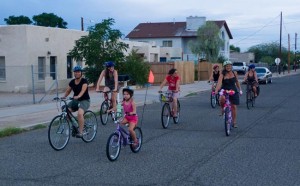
While out for a training ride last week, I got a flat tire, actually it was the second flat tire during the 30-mile hill climbing ride in the foothills.
While I was changing it, a woman who was out for a run came up to my friend and I and asked if I had a flat tire.
She told me she would really like to ride a bike, but was concerned about what would happen if she got a flat.
A lot of new cyclists feel the same way when they start riding. I know I did. I hear from some women who say that learning how to change a tire and work on their bikes can be intimidating.
I asked the woman to email me, so I could send her some resources that would help her get started. I’ve yet to hear from her, but I thought it might be useful to some people who want to help their significant other, mother, friend, daughter, whoever — get into riding.
One of the biggest barriers to women who want to ride seems to be not knowing how to change a tire if it goes flat. When my wife got a flat on her first solo trip with Luci on the Xtracycle, it threatened to derail her riding adventures.
We decided that because changing a flat tire on an Xtracycle can be a pain, especially with a kid, we wanted to try our best to prevent flats in the first place.
We upgraded the tires to a good Continental brand tire with flat protection, added a tire liner and got thorn resistant tubes. We decided the extra weight and rolling resistance was a small price to pay for having to worry less about flat tires.
She also has a can of bicycle tire sealant and compressed air in her bags so that she can hopefully fill up her tire and get home where it will be easier to change it.
Remember to keep your tires properly inflated and try to avoid riding through glass and road debris.
Prevention is great, but knowing how to change a tire is important.
Here are some resources to help you learn:
The city and county provides free classes to help women get started. They offer women specific classes in cycling safety and a basic mechanics class that focuses on changing tires. Download the schedule here.
Tucson’s BICAS has shop hours for women and transgendered cyclists from 12-6 p.m. every Sunday. The female mechanics on hand can help you learn to change your tire. There is a $4 per hour fee to use the equipment and get help from the mechanics. BICAS does offer work trade if someone can’t afford the fee.
Here is a great link with instructions about changing or patching a flat tire.
Lastly, check out this video to see how to change a tire.

Back when I worked in a local bike shop, flat tire repair was our #1 repair. Nothing else came close.
So, gals, learn to fix those flats. It could lead to a bike shop job.
I have a tip for finding flats that I stumbled upon by accident. I had a flat near 6th Ave and Speedway once so I walked over to the 7-11 to fix it and I purchased a sandwich and a bottle of water while I was there. After I ate my sandwich I noticed the plastic clam shell would be perfect as a water reservoir so I put some water in it and ran my tube through it. Viola! I found the hole and patched it. I keep the clam shell in my backpack all the time now. There’s different sizes and shapes depending on what type of sandwich you buy. Here’s a photo of mine.
[…] Follow this link: Resources for women who want to ride | Tucson Velo […]
I took a free class at There & Back bikes, which was great (and came in handy, as I had gotten my first flat shortly before then).
My latest personal bike advocacy campaign is to persuade all Tucson bike shops to sell teflon tire-liners at extremely low cost. I think that saturating the market with tire liners would lead to a noticeable increase in Tucson ridership, especially among new riders.
Tire liners dramatically reduce flats, and the potential for a flat reduces cyclings reliability as a way to get somewhere at a predictable time. Many people in town have a bad experience with getting a flat far afield and having to schlep their way home, and of course Tucson’s billions of thorns and goatheads make flat tires a consistent problem if you don’t ride expensive tires and/or tire liners.
And the reality is that many people just don’t want to learn to fix flats and certainly don’t want to have to do it on the side of the road.
But those tire liners are pricey. I think if we made an effort to reduce the price and advocate their use, there would be more cyclists on the streets.
BICAS, by the way, recently decided to begin supplying tire liners essentially at cost pending discussions with local bike-shop owners (BICAS has a policy not to undercut LBS pricing, so they need to discuss this change with some LBS’s before implementing it).
Tire liners change everything. I won’t ride without them. They’re only about 12 bucks per wheel — not super-cheap, but they last for the life of your bike and deliver car-tire-type reliability, particularly if your tires are in the 1.5-1.75 range. Too bad some shops discourage their use — Fairwheel for one.
Mike! Thank you so much for giving a shout out to the BICAS Sundays and supporting our cause. Just an fyi: Sundays are 12-4pm now. Thanks again for all you do!